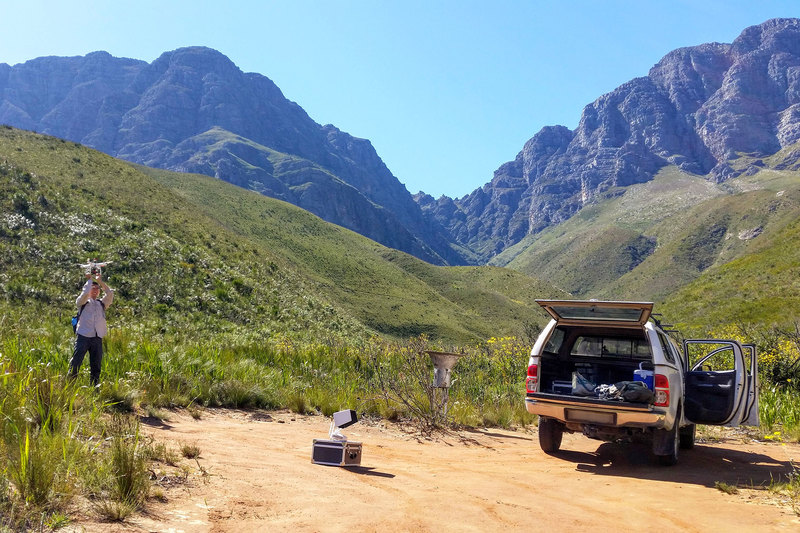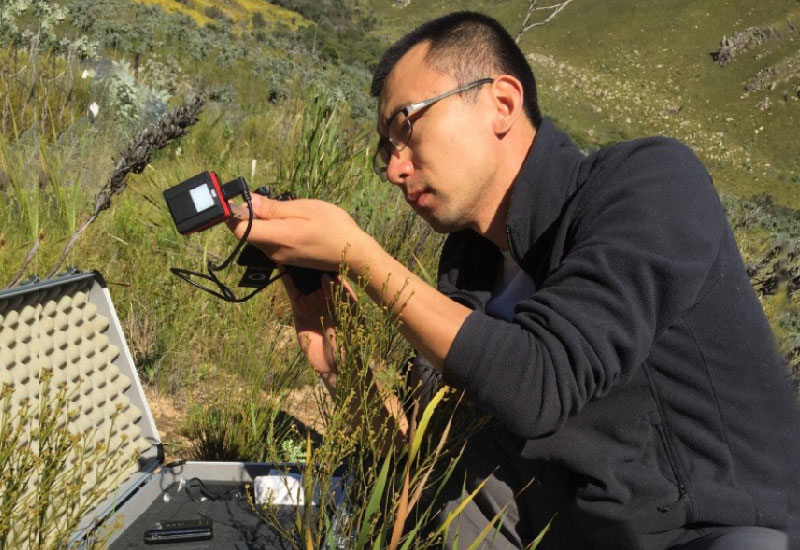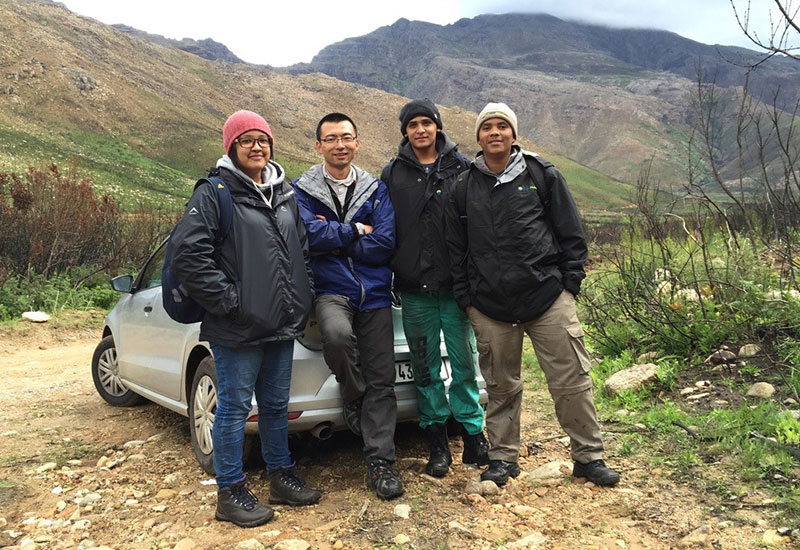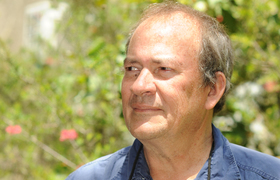Fynbos puts the squeeze on trees via the thinnest roots known
15 February 2022 | Story Helen Swingler. Read time 8 min.
Fynbos and Afrotemperate Forest biomes live side by side in the Western Cape, sharing an underlying geology and climatic patterns. Each survives in very different soil, produced by the vegetation. However, the fynbos biome relies on a unique adaptation to keep trees off its turf.
Scientists call the phenomenon “alternative stable states”, which underpins a new international study by the Santa Fe Institute (SFI) in the United States with the University of Cape Town (UCT). The results appeared in a new paper, “Biome boundary maintained by intense belowground resource competition in world’s thinnest-rooted plant community”, published online on 14 February 2022 in Proceedings of the National Academy of Science.
The lead author is SFI Omidyar Fellow Dr Mingzhen Lu. The corresponding author is Princeton University’s Professor Lars Hedin (Ecology and Evolutionary Biology Department), with UCT’s Emeritus Professor William Bond (Department of Biological Sciences) and several other UCT authors.
Root systems and biodiversity
The paper describes how fynbos plants are able to maintain the poor soil conditions that they are adapted to thrive in – and how the abutting forest biome ends up being so different, contributing to biodiversity, despite the same starting geology and environmental conditions.

Underpinning the contrasts are root systems, the foundation of biodiversity, said Dr Lu. Stringy roots allow the highly diverse, shrubby fynbos species to outcompete thicker-rooted plants, like trees, by accessing scarce belowground nutrients.
“For the past 400 million years, since plants colonised land, roots have been the true engine of terrestrial nutrient cycling.”
Lu was initially trained in China where he developed a special interest in roots and root competition. He conducted this study while working on his PhD with Professor Hedin.
“For the past 400 million years, since plants colonised land, roots have been the true engine of terrestrial nutrient cycling,” Lu explained. “It is profound to see microscale plant traits, like root thickness, linked to macroscale emergent ecosystem patterns.”
This ability may be key to survival in an era of climate change.
Research roots and networks
Hedin and Princeton colleague Simon Levin had previously collaborated with Emeritus Professor Bond on a project supported by the Andrew W Mellon Foundation. Bond and colleagues also worked on forest versus fynbos soils as part of a UCT biome project. Hedin got involved and later arranged for Lu to work with the UCT team.
Contrasting ecosystem properties between forest and fynbos were quantified at Orangekloof on the Cape Peninsula while the processes behind the contrasts were explored in a four-year manipulated experiment in the Jonkershoek valley near Stellenbosch.
Forest tree seedlings were planted in post-burn fynbos soils with and without nitrogen or phosphorus fertiliser and with or without a screen preventing fynbos roots from competing with the roots of the forest saplings.

Here the study relied on another network, the support, technical and research team of UCT botanists and plant physiologists who were also co-authors of the paper: Emeritus Associate Professor Ed February, Professor Michael Cramer and Professor Adam West, Associate Professor Samson Chimphango and Dr Jasper Slingsby.
“Measurements of responses required some technology: a drone with a multispectral camera and a scanner for the measurement of underground root traits,” said Bond. “These primary roots are very small – the very first produced.”
“Across the world’s ecosystems, these [fynbos] roots are the thinnest of all,” Lu said. “For every 1 g of carbon – the weight of a paperclip – these plants produce roots 15 football fields longer than forest species.”
Or, as Bond commented, “Imagine drilling for gold nuggets (nutrients), 15 times faster than the competition – it’s no contest!”
Alternative stable states
The study also showed how alternative stable states contrast with the standard idea of plant succession, said Bond.
“We now see that it is not the intrinsic soil properties, but plant feedbacks to the soil, that create misery for forest saplings.”
“[Succession is] where a disturbance opens up a forest, say, pioneer species arrive and gradually re-build the forest. With alternative stable states, the disturbance opens up the forest, fynbos invades, changes the environmental conditions to suit itself at the expense of the trees, and, with repeated disturbances (such as by fire), persists where forest once grew.
“The thin roots of fynbos are the belowground weapon creating miserable conditions for nutrient-demanding forest plants. We now see that it is not the intrinsic soil properties, but plant feedbacks to the soil that create nutritional misery for forest saplings.”
Compounding this, the fynbos biome is prone to frequent, hot fires that cause the destruction of accumulated nutrients in the soil, said Bond.
“The nutrient-mining belowground strategy combined with very slow litter decomposition and a collective fire-adaptation allows the fynbos plant community to favour its own persistence by modifying its environment. On the other side of the biome divide, the forest is doing the converse thing.”
Roots are key to biodiversity
The findings suggest that alternative stable states can be maintained through biotic mechanisms, such as root traits, in addition to the commonly understood abiotic factors like climate. This insight is critical to conserving threatened ecosystems around the world.
“Roots are the foundation of biodiversity,” said Lu.
This makes them especially interesting as models for dramatic change because they can switch from one state to another, said Hedin. “This is especially urgent in a world being stressed by climate change.”
“Trees could invade those soils, enrich them and oust fynbos for generations to come by making them more fertile.”
But it’s a fragile status quo.
“Trees could invade those soils, enrich them and oust fynbos for generations to come by making them more fertile,” Bond noted. “Then again, the warmer climates could promote more extreme fires which might reverse the trend we have seen of forest expansion over the last several decades.”
“The idea that plants create their own environmental conditions, rather than adapt to existing conditions, has emerged gradually from studies of open and closed (forest) ecosystems around the world. In this case, two distinct ways of living have evolved, forest and fynbos, competing with each other for the same living space.”
To live in one or other system, plants would have to conform to local conditions (shade/light, fertile/infertile; no fire/fire) but those conditions are made by the plants themselves, Bond said.
“This is quite different from the more familiar idea that the plants growing at a site are those best adapted to that site. Hence fynbos soils are not inevitably nutrient-poor: diverse fynbos species keep it miserable, promoting infertile conditions to which they are well adapted, but which are ’miserable’ for their forest competitors.”
 This work is licensed under a Creative Commons Attribution-NoDerivatives 4.0 International License.
This work is licensed under a Creative Commons Attribution-NoDerivatives 4.0 International License.
Please view the republishing articles page for more information.










